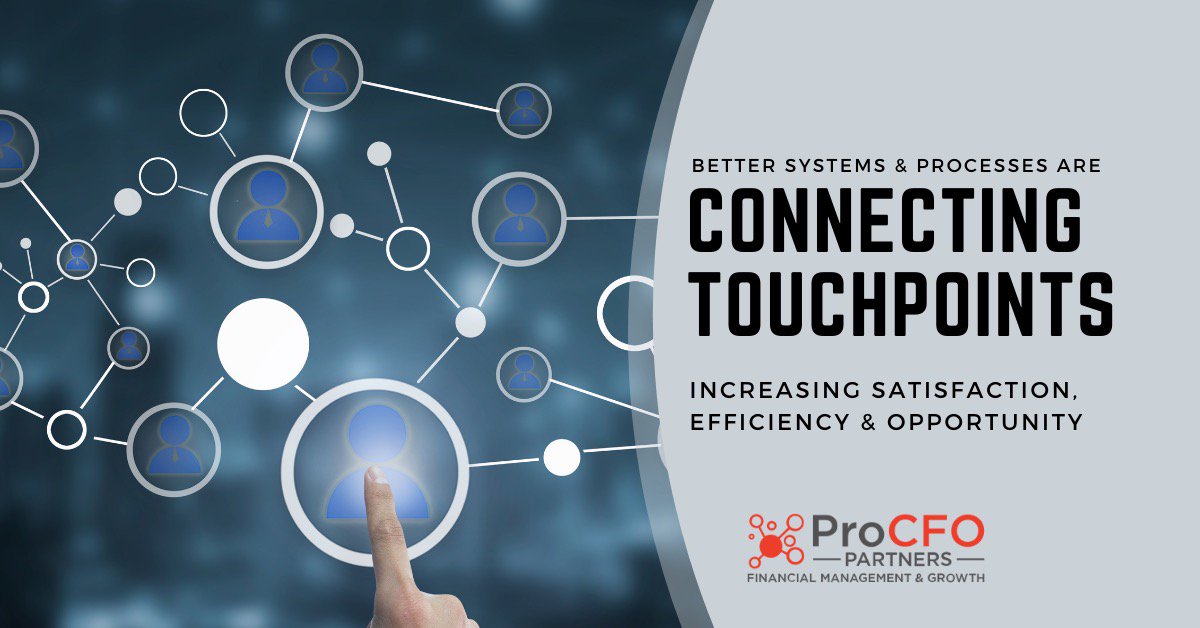Control Process And Systems
Dec 24, 2020
When we explore systems and processes that drive a business, we start by trying to understand where there’s a single point of truth in an organization. This is information stored in a business application that the processes you need in your business all connect to and ultimately can deliver from. Sales, marketing, manufacturing, accounting – everything ties into that store of information to tell you what’s going on with the company.
Systems and Processes: The Basics
Companies start out, and smaller businesses might maintain, this information in a collection of spreadsheets or using an online accounting application like Quickbooks Online. A Customer Relationship Manager (CRM) is a system that can drive sales and marketing insight or action. If you’ve ever heard the term “a book of business” talking about a sales rep’s list of contacts, this references the earliest, analog systems and processes – a literal book or Rolodex of information.
The Importance of Growing Your Systems and Processes
Many companies start with something that makes sense when it’s very small, maybe just a few people. A spreadsheet or modest cloud platform might be sufficient for basic financial reporting or customer list. As the needs for business insight get more sophisticated, it’s important for a company’s systems and processes around them to keep pace with speed and innovation. The spreadsheet that was sufficient when there were two employees and $20,000 in revenue won’t work when there are twenty employees and $20 Million in revenue.
Symptoms You’re Outgrowing Your Existing Systems and Processes
There are some telltale indicators that it’s time to scale up or investigate new solutions to manage business information.
- When your information is inaccurate or incomplete
- When you have redundant processes
- When you have multiple systems among different departments that aren’t connected to each other
- When you’re receiving customer or end user complaints about things like billing or invoicing, shipping, or fulfillment.
- You find you have workarounds to manage inefficiencies
- There are a lot of manual processes, requiring significant human interface, such as manually entering something into a spreadsheet
Obstacles to Improving Systems and Processes
We tend to get used to what we know, which can keep us from scrutinizing our systems and processes and finding opportunities for improvement. We may have spent a lot of money on a platform and time training and onboarding to it, making us resistant to consider change if that platform doesn’t serve us well or we outgrow it.
When we’re stuck in inefficient or ineffective systems and processes, we’re trading time for innovation. Taking the time to upgrade can feel intimidating or daunting, so we push it off and kick the can. Eventually the systems we’ve outgrown will stifle our ability to move quickly, make smart decisions, or see opportunities.
At Disney’s animation studios in Burbank, California, there are a series of underground tunnels. These were so artists drawing on cellophane sheets could carry the sheets from one department to another without exposing their artwork to the elements, potentially ruining them and delaying an upcoming project. The costs, resources, and training required to manage delivery of project-critical assets from one department to another via underground tunnels was immense. Yet, imagine if Disney had been slow to innovate just because they were used to this, or it was expensive. Pull the thread on this old process long enough and you’ll arrive to today, where the entire animation project is managed digitally from start to finish.
Improving Your Systems and Processes
If you’ve recognized that your systems or processes are outdated or you’re experiencing some symptoms that you’ve outgrown them, it’s time to start making changes.
- Identify where your bottlenecks in process are, so you can track and report on where the issues exist. It could be a staffing or training issue, or a new system is in order to solve an issue.
- Try and replace significantly manual labor without something more predictable and less prone to human error. If your website collects email addresses from prospects, for instance, and a human being copies and pastes that information into some system, this is a process that can be automated to be more frictionless.
- Connect your systems. If your website is connected to your CRM, connect your CRM to your Enterprise Resource Planning (ERP) to help integrate and manage different aspects.
Looking To Your CFO for Leadership
A great CFO should be future minded about your systems and processes, in fact guiding the entire company in a way where you’re never reacting to outgrowing a system or process because you’re constantly keeping pace. Your CFO should be naturally assessing all facets of an organization, capable of seeing where important issues might be hiding. Systems and processes are an essential gear in the machinery of how a successful business runs. Having a skilled “technician” in a CFO who can see the holistic relationships at work in your organization is key to increasing efficiency and effectiveness.


